Structural and functional characterization of microcin C resistance peptidase MccF from Bacillus anthracis.
Nocek, B., Tikhonov, A., Babnigg, G., Gu, M., Zhou, M., Makarova, K.S., Vondenhoff, G., Van Aerschot, A., Kwon, K., Anderson, W.F., Severinov, K., Joachimiak, A.(2012) J Mol Biol 420: 366-383
- PubMed: 22516613
- DOI: https://doi.org/10.1016/j.jmb.2012.04.011
- Primary Citation of Related Structures:
3GJZ, 3SR3, 3T5M, 3TYX, 3U1B - PubMed Abstract:
Microcin C (McC) is heptapeptide adenylate antibiotic produced by Escherichia coli strains carrying the mccABCDEF gene cluster encoding enzymes, in addition to the heptapeptide structural gene mccA, necessary for McC biosynthesis and self-immunity of the producing cell. The heptapeptide facilitates McC transport into susceptible cells, where it is processed releasing a non-hydrolyzable aminoacyl adenylate that inhibits an essential aminoacyl-tRNA synthetase. The self-immunity gene mccF encodes a specialized serine peptidase that cleaves an amide bond connecting the peptidyl or aminoacyl moieties of, respectively, intact and processed McC with the nucleotidyl moiety. Most mccF orthologs from organisms other than E. coli are not linked to the McC biosynthesis gene cluster. Here, we show that a protein product of one such gene, MccF from Bacillus anthracis (BaMccF), is able to cleave intact and processed McC, and we present a series of structures of this protein. Structural analysis of apo-BaMccF and its adenosine monophosphate complex reveals specific features of MccF-like peptidases that allow them to interact with substrates containing nucleotidyl moieties. Sequence analyses and phylogenetic reconstructions suggest that several distinct subfamilies form the MccF clade of the large S66 family of bacterial serine peptidases. We show that various representatives of the MccF clade can specifically detoxify non-hydrolyzable aminoacyl adenylates differing in their aminoacyl moieties. We hypothesize that bacterial mccF genes serve as a source of bacterial antibiotic resistance.
Organizational Affiliation:
Center for Structural Genomics of Infectious Diseases, National Institute of Allergy and Infectious Diseases, Bethesda, MD 20892-6612, USA.














